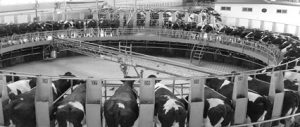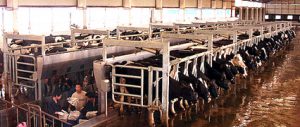Dairy products are a major source of nutrition in the United States. With government policy support for commercialised agriculture, both total milk production and milk yield per cow have risen, as has average consumption of dairy products. But over the long term there has been a slow decline in the amount of fresh milk drunk per person.
And as the dairy industry has developed, doubts have been raised over the quality of dairy products. Livestock rearing technology – in particular the use of growth hormones and recombinant bovine growth hormones – increased milk yields by an incredible 24% between 1998 and 2011.
However, when milk is seen as only a foodstuff, and cows as just a means of production, food production breaks with fundamental natural laws and rhythms. This has far-reaching consequences for both humanity and animals. Cows farmed traditionally on the Mongolian plateau are milked for the five months after giving birth to a calf. But on the industrialised farms of the US cows are milked for 300 days of the year – meaning that cows are milked while pregnant, increasing the amount of oestrogen in the milk.
The American people have, in some cases, gradually come to realise the danger of agriculture becoming disconnected from nature. In response, organic and local food production has become more popular. Organic Valley, a dairy cooperative with headquarters in Wisconsin, is just one of the companies now meeting a strong consumer demand for safe dairy products and responsible, environmentally-friendly options.
The co-op, in which every farmer gets a share of the profits, got started in 1988. Agricultural policy was leaving small and medium-scale farms with a dilemma: expand, or quit. But the farmers of the La Farge valley in the south of Wisconsin didn’t like either option. So George Siemon and half a dozen other farmers talked about joining forces in order to continue localised farming – and produce better and more local food than the big farms and agribusinesses. The response was overwhelming.
The co-op soon identified consumer concerns about the quality and environmental impact of industrial milk production and decided to focus operations on dairy products. Unhappy with the exploitative prices paid on the market, they sold their organic milk themselves. The organisation grew as more family farms signed up. In 2007, the co-op became America’s second largest dairy producer and by 2010 sales had reached US$555 million.
Although part of a rapidly growing operation, everyone is clear that they are working for the farmers. In early 2007, Organic Valley had 1,056 member farms – 10% of all organic farms in the US – across 24 different states. By 2012 it had 1,723 member farms.
According to Organic Valley, “family farms and cooperatives both make a promise to the community: that we can provide the healthy, natural and nutritious local foods that have been taken away by corporate farming.” At the start the co-op was made up of local small family farms, but it soon expanded nationwide. Today the co-op is open to small and medium-sized farms – but not large commercial farms. As producers are small and scattered, the co-op established a milk collection and distribution system and regulations.
All farmer members must follow strict regulations. For example, 80% of cow fodder must be green grass; and all organic products must be sold to Organic Valley at prices set by the board. As all of Organic Valley’s dairy farmers are small family operations – even the largest has fewer than five hundred cows – the key to the co-op’s success was voluntary respect for the regulations. That is why CEO George Siemon says the most important factor in the co-op’s success is farmers who rely on and are loyal to each other.
If market prices fluctuate, farmers still get the agreed prices. That means the risks of price fluctuations – due to nature or the market – are shared across the co-op. The farmers just need to do their part – providing quality milk.
The prices set by the farmers’ board are always higher than market prices. When designing the co-op the founders tried to put together economically-viable pricing rules, which would leave both profit for the member farms and not leave the co-op paying prices it could not afford. The key was to persuade consumers to pay a fair price for natural and organic milk, and to cut down intermediary and logistics costs. Ultimately customer recognition of organic products earned profits, allowing prices to be set much higher than those for ordinary milk. Twenty years later the co-ops prices have steadily risen – as opposed to industrial milk prices, which have fluctuated wildly. The price differential between the two types of milk was 7.10 dollars in 2010 – up from 2.10 dollars in 1989 – and the farmers get a fair price for all their dairy products.
The market for organic and local food is created by demand. The first important thing is to ensure that ingredients are local and organic. The second is to increase value through appropriate degrees of processing and branding. Most profits are ultimately returned to member farms, or retained to fund the long-term growth of the co-op. Therefore adding value further raises the confidence of member farms in the co-op, and promotes its long-term expansion.
The co-op has faced challenges during its growth. For example, when it was expanding most rapidly there were doubts about its ability to manage such a huge number of farms and possible resulting quality issues. The co-ops shareholding structure led to clashes between the ideals of the two systems; and there were problems with management and profit allocation principles.
But people saw that Organic Valley welcomed these challenges, and that this co-op model created a new market. At a time when food safety was threatened by the way the dairy industry was developing, this allowed consumers to opt to pay a fair price to support a short supply chain between consumers and local producers – providing a new choice for both policymakers and shoppers. This is something China’s dairy industry, which has lost consumer confidence, could learn from.
Zhou Li is deputy professor at the School of Agricultural and Rural Development, Renmin University.
Homepage image by Organic Valley






